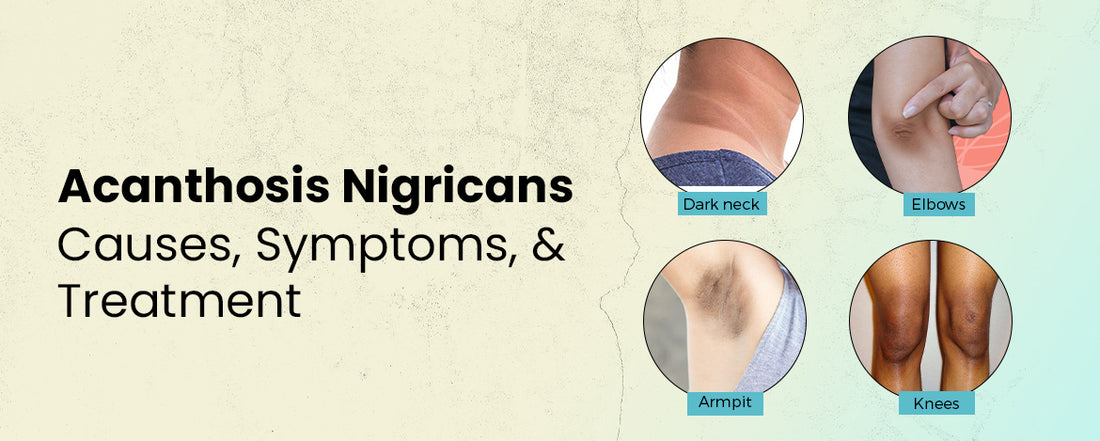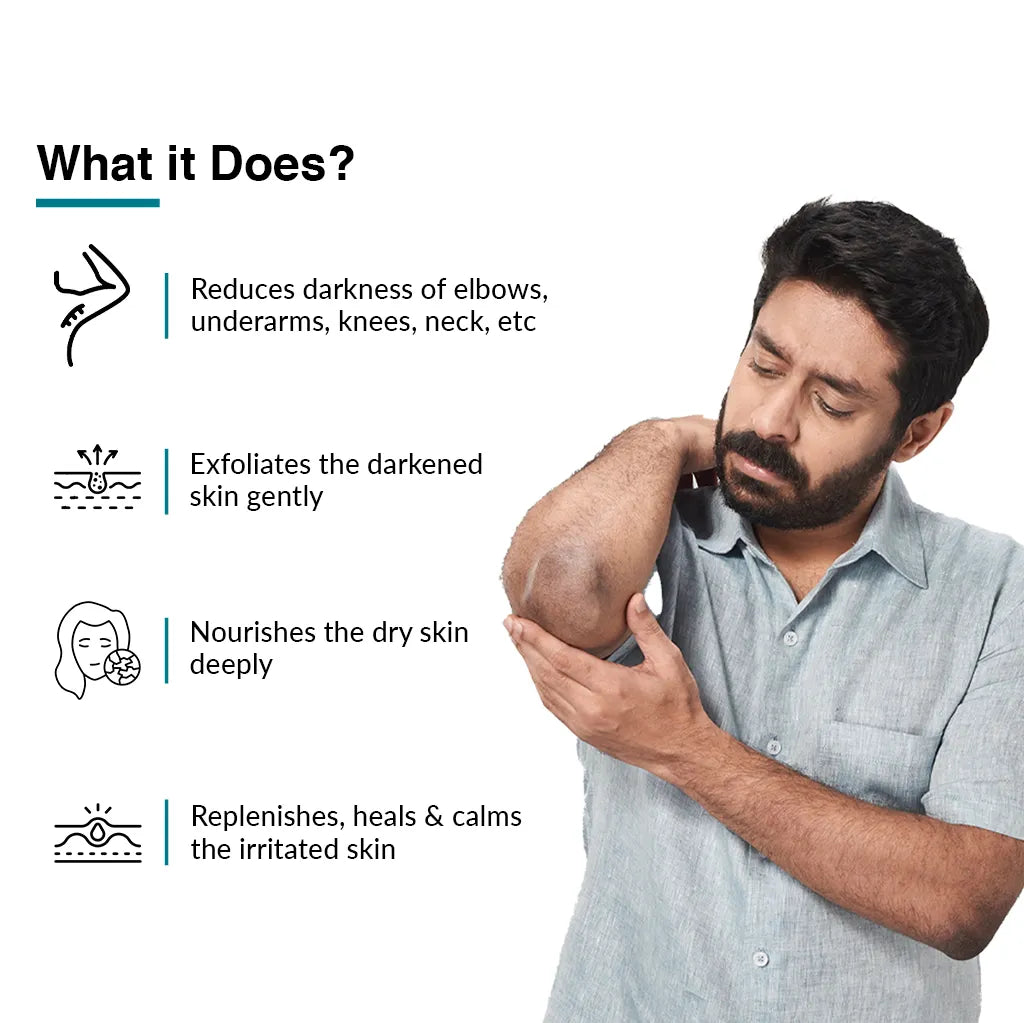Acanthosis Nigricans: Causes, Symptoms, and Treatment

Acanthosis Nigricans (AN) is a skin condition characterized by the thickening and darkening of certain areas of the skin, often appearing as velvety, brown-black patches. These patches typically occur in skin folds and creases, such as the neck, armpits, groin, and under the breasts. While AN itself is not a harmful condition, it can be indicative of underlying health issues. It is a dermatological condition that affects millions of people worldwide. Despite its prevalence, it remains relatively unknown to many. This blog aims to shed light on AN by discussing its types, causes, symptoms, and management strategies.
Types of Acanthosis Nigricans
Acanthosis Nigricans can be categorized into several types, each associated with different underlying causes and risk factors:
- Obesity-Related Acanthosis Nigricans: Obesity-related AN is the most common type and is often linked to insulin resistance. It typically develops in individuals with a high body mass index (BMI) and can affect various body areas, including the neck, armpits, and groin. Insulin resistance plays a significant role in this type of AN, as it leads to elevated levels of insulin in the bloodstream, which can stimulate the growth of skin cells and increase pigmentation.
- Genetic Acanthosis Nigricans: This type of AN is hereditary and can affect individuals from a young age. It tends to be more severe and covers larger areas of the body. Genetic AN can be associated with certain genetic mutations that affect how skin cells respond to insulin.
- Medication-Induced Acanthosis Nigricans: Certain medications, such as oral contraceptives, corticosteroids, and high-dose niacin, can lead to AN as a side effect. This type of AN is reversible and usually fades when the medication is discontinued, or the dosage is adjusted.
- Malignancy-Associated Acanthosis Nigricans: In some cases, AN can be a paraneoplastic syndrome, meaning it is associated with an underlying cancer, often a gastrointestinal or genitourinary malignancy. This type of AN typically occurs suddenly and is more severe than other types. If someone develops AN without an apparent cause or if it progresses rapidly, it's essential to seek medical evaluation to rule out an underlying malignancy.
- Endocrine Acanthosis Nigricans: Endocrine AN is associated with hormonal imbalances, such as polycystic ovary syndrome (PCOS), Cushing's syndrome, or thyroid disorders. Hormonal changes can lead to insulin resistance and contribute to the development of AN in affected individuals.
Common Symptoms of Acanthosis Nigricans
The primary symptom of AN is the presence of dark, thickened patches of skin. These patches can be:
- Dark Brown to Black: The coloration of AN-affected skin is typically darker than the surrounding skin.
- Velvety or Rough Texture: The affected skin often feels velvety or rough to the touch.
- Localized to Skin Folds: AN commonly occurs in skin folds and creases, where friction and sweating are more likely.
Other than the visible changes in the skin, individuals with AN may not experience any other symptoms. However, the condition itself may be a sign of underlying health problems, such as insulin resistance, hormonal imbalances, or malignancies, as previously mentioned.
Diagnosis and Management
Diagnosing AN usually involves a combination of clinical evaluation and, in some cases, further tests to determine the underlying cause. Here are some key aspects of managing AN:
- Identifying and Addressing Underlying Causes
The first step in managing AN is to identify and address any underlying conditions or factors contributing to its development. This may involve:
- Weight Management: In cases of obesity-related AN, weight loss and lifestyle changes to improve insulin sensitivity can be highly beneficial.
- Hormonal Assessment: If endocrine disorders are suspected, hormone levels should be evaluated, and appropriate treatment initiated.
- Medication Review: For medication-induced AN, consulting with a healthcare provider to adjust medications or explore alternative treatment options is essential.
- Malignancy Screening: In cases of malignancy-associated AN, a thorough evaluation for potential cancers is critical.
- Topical Treatments
While there is no cure for AN, various topical treatments can help improve the appearance of affected skin:
- Topical Retinoids: Prescription retinoid creams can help exfoliate and lighten the affected skin.
- Alpha Hydroxy Acids (AHAs): AHAs, such as glycolic acid, can promote skin cell turnover and reduce pigmentation.
- Laser Therapy: In some cases, laser therapy may be recommended to lighten and smooth the affected areas.
- Lifestyle Changes
For individuals with obesity related AN, making lifestyle changes is essential. These may include:
- Weight Loss: Achieving and maintaining a healthy weight can significantly improve insulin sensitivity and reduce AN symptoms.
- Dietary Modifications: A balanced diet with reduced sugar and refined carbohydrate intake can help manage insulin levels.
- Regular Exercise: Incorporating regular physical activity into daily routines can aid in weight management and improve insulin sensitivity.
- Psychological Support
AN can have a significant impact on self-esteem and body image due to its visible nature. It's important to provide psychological support and counseling for affected individuals to help them cope with the emotional aspects of the condition.
Nigrifix Cream: The dermatologist approved solution for Acanthosis Nigricans
Nigrifix Cream stands out as a highly effective topical solution for Acanthosis Nigricans, and its efficacy can be attributed to its key ingredients: urea, lactic acid, tea tree oil, and retinol. This unique combination of ingredients addresses the underlying causes and symptoms of Acanthosis Nigricans in a comprehensive manner.
Urea, a potent humectant, plays a crucial role in this cream by deeply moisturizing the affected skin areas. This hydration is essential in treating Acanthosis Nigricans as dry and thickened skin is a common symptom of the condition. Lactic acid, an alpha hydroxy acid (AHA), helps exfoliate the skin gently, removing dead skin cells and promoting cell turnover. This aids in reducing the hyperpigmentation associated with the condition, gradually revealing smoother and healthier skin.
Tea tree oil, known for its antibacterial and anti-inflammatory properties, helps in managing any potential skin infections that may occur due to the friction and irritation associated with Acanthosis Nigricans. It also soothes itching and discomfort, improving the overall quality of the skin.
Retinol, a derivative of vitamin A, is a powerful ingredient in Nigrifix Cream because it stimulates collagen production and skin cell renewal. By enhancing skin elasticity and reducing the appearance of dark patches, retinol helps restore a more even complexion to the affected areas.
What sets Nigrifix Cream apart is its holistic approach to Acanthosis Nigricans. This cream is highly effective and safe to use on the skin. Regular use of this cream, followed by sunscreen in the daytime, not only aids in fading dark patches but also helps prevent their recurrence by improving overall skin health. This combination of key ingredients makes Nigrifix Cream a standout choice for individuals seeking an effective topical solution to manage Acanthosis Nigricans and regain confidence in their skin's appearance.
Prevention and Outlook
Preventing AN often involves maintaining a healthy lifestyle that includes regular exercise, a balanced diet, and weight management. Early detection and management of conditions like diabetes and hormonal imbalances can also reduce the risk of developing AN.
The outlook for individuals with AN varies depending on the underlying cause and the effectiveness of treatment. In cases where AN is related to obesity and insulin resistance, improvements in lifestyle and weight management can lead to significant reductions in symptoms. However, in cases associated with malignancies or genetic factors, the focus is on managing the underlying condition.
In conclusion, Acanthosis Nigricans is a dermatological condition with various types, each linked to different underlying factors. While it primarily affects the appearance of the skin, it can also serve as a valuable indicator of underlying health issues. By identifying and addressing the root causes, individuals with AN can take steps to improve their overall well-being and quality of life. If you suspect you have AN or are concerned about changes in your skin, it's essential to consult a healthcare professional for a proper evaluation and guidance on treatment and management.
Read more - Hand Cream: Nurturing Your Hands to Perfection






